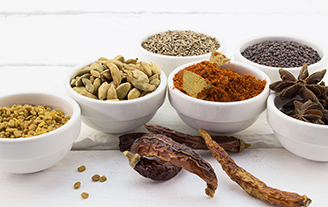by Kat Reese
edited by Karla Mohtashemi

Are the same old dishes getting boring day after day? You can turn simple meals into culinary experiences by just switching up your spice cabinet! I love to bulk meal prep, and usually stay with the same staple items like baked or grilled meats, vegetables and grains. Here are some of the top Middle Eastern spices to help give your boring routine a little kick! These can all be found at your local Middle Eastern market, Penzeys Spices, or PCC! (Sometimes International markets will also carry these!) I’ve included a link to order some of these spices online, through shop.com. Shop.com can give you money back for online shopping.
Fenugreek
With a sweet, nutty taste that blends well with other spices, Fenugreek is delicious in soups, stews, and rubs. The dried seeds are used whole or crushed/powdered. The spice is said to have medicinal properties and can help with blood sugar control and balancing hormones.
Coriander/Cilantro
Though it makes an appearance in many Hispanic foods, Cilantro is originally from Israel and has been used in Middle Eastern foods since Neolithic times! In the US, we call the leaves Cilantro and the seeds Coriander. Both imbue a unique tart, earthy, fresh aroma and taste. Watch out! Some individuals have a gene that makes cilantro taste soapy. Many people who experience this are fine eating the seeds (Coriander) though! Do you or someone you know have that gene? What do Cilantro leaves taste like to you? Order Coriander online, here.
Turmeric
I love turmeric in and on just about everything. The taste is understated, adding an earthiness to dishes from soups and stews to vegetables to curries. It is an amazing anti-inflammatory and imbues a beautiful yellow hue to foods. It has become so wonderfully popular, I bet you probably already use it! Boost the benefits of turmeric by adding black pepper! Online order here.
Zareshk/Barberries
Not technically a spice, but definitely something to spice up your meals! Traditionally used in a Persian rice dish called “Zareshk Polo”, Barberries are an amazingly sweet and sour addition to savory dishes. They come dried and can be sauteed in a little oil and water to plump back up for everything from oatmeal to baked goods to anything you might put raisins on! Extremely high in vitamin C, this berry is sure to brighten your day! If you have kids that like sour candies, this is a healthy alternative with a yummy tang. Online order here.
Cardamom
In use at least since the Early Bronze Age Babylonians, Cardamom has been a prized spice throughout history. Known for its fruity, zesty flavor, it pairs well with ‘Holiday’ spices like Cinnamon, Nutmeg, and Cloves. Together these spices make a great mix for sweet AND savory dishes! (If you’ve never had Allspice in tomato sauce, you don’t know what you’re missing!) Cardamom pods are also a common addition to Persian tea, broken and added in during the steeping process releases the floral, peppery taste. Online, order here.
Rose
Petals, water, buds, Middle Eastern food uses it all! You can find rose water in everything from cookies and baklava to meats and rice dishes! Roses have been used for their anti-inflammatory, antioxidant rich properties when eaten, and also in treatments for the skin and hair. Just remember, a little goes a long way!
Saffron
Okay, okay… yes, it’s expensive… but you don’t need a whole lot to pack a punch! Ever wonder where that beautiful, florally fragrant yellow rice comes from? It’s Saffron! Saffron has mild, sweet, floral, earthy taste to it. It is made up of the delicate stigma of the Saffron Crocus, and iis used by creating a ‘tea’ with the stigma and adding that to the recipe. It goes well with almost everything, though I’m especially fond of saffron butter cookies (shhh… only for special occasions!) It’s use dates back 50,000 years to modern Iran where it was said to have curative and aphrodisiac properties! Online, order here.
